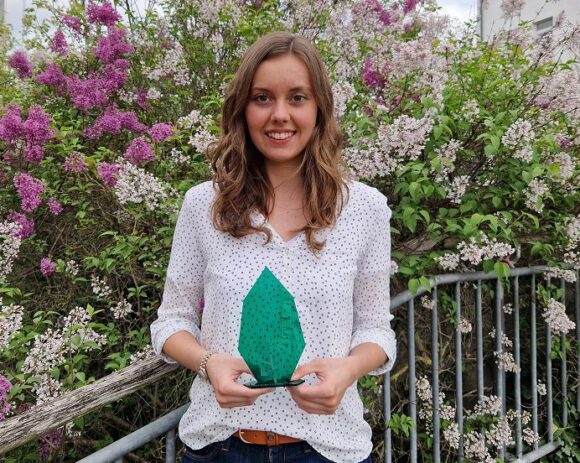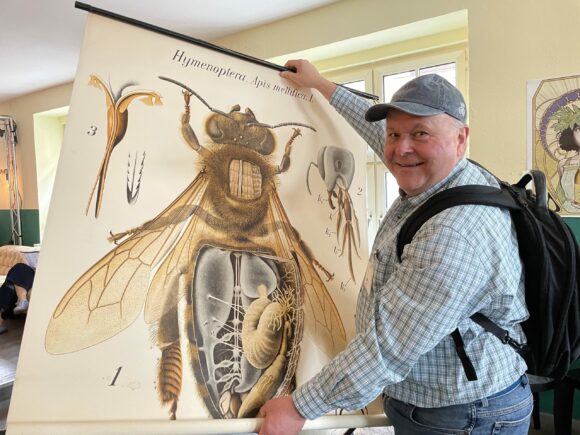In the province of Almería in southern Spain, the German Aerospace Center (DLR) – Institute of Solar Research has access to the “Plataforma Solar de Almería” of the Spanish research center CIEMAT. Researchers use the power of the sun here to test and improve high-temperature solar technologies under realistic conditions. Laura Paulus from Hof University of Applied Sciences is currently writing her Master’s thesis there and reports for “campuls-digital”.

A glance out of the window in the middle of the cloudy, humid German February reveals that there are probably worse places to build your Master’s degree than sunny Andalusia, especially in the winter semester. For Laura Paulus, however, the warm weather in Spain’s southernmost region is of course just a pleasant side effect: she is currently working intensively on her thesis on behalf of the German Aerospace Center(DLR). This involves wind measurements within a large CIEMAT solar field and the resulting mechanical loads on the solar mirrors. The thesis is being supervised internally by Dr. Natalie Hanrieder, a long-time employee at the Almeria site, and at the university by Prof. Tobias Plessing, Head of the Institute for Hydrogen and Energy Technology at Hof University of Applied Sciences (iwe).
The dream of a stay abroad
For Laura Paulus, the acceptance of her application fulfilled a long-cherished wish: “I really wanted to go abroad again before the end of my studies. And as I had already completed all my exams, I was thinking of a kind of internship that I could write my Master’s thesis about. In terms of subject matter, I always had the field of renewable energies in mind. I was only limited by the fact that, apart from German, I only speak English fluently.” Nevertheless, the search turned out to be far more difficult than expected. Many applications failed and almost made the Master’s student give up the idea of writing her thesis abroad completely. Then, however, she stumbled across the DLR offer almost by chance:
‘The topic simply fitted and would have been my favorite anyway if I had been looking within Germany. The fact that working at a German research institution ended up taking me abroad was probably a stroke of luck.”
Laura Paulus
World-leading test center
After her application was accepted, she quickly took a plane to Malaga and from there a bus to Almeria, where she now lives and works very centrally. At the “Plataforma Solar de Almería” (PSA), around 40 km from the city gates, there are solar mirrors of various shapes on more than 20,000 square meters and in various test facilities.

Image: www.psa.es/es;
There, differently shaped solar mirrors can be found on more than 20,000 square meters and in various test facilities. The mirrors concentrate direct solar radiation to generate high and very high temperatures. These facilities, some of which appear futuristic in the barren landscape, currently form the largest European and, in terms of diversity, the world’s leading test center for concentrating high-temperature solar technology. The PSA is owned and operated by the Spanish research center CIEMAT, a long-standing cooperation partner of DLR. DLR played a key role in the planning and construction of the PSA and uses it for its own solar technology testing and development work with scientific personnel stationed on site.
Evaluation of wind loads on solar mirrors
Laura Paulus is now also part of the DLR team, which consists of researchers from the fields of mechanical engineering, energy technology, meteorology and electrical and environmental engineering. She explains: “I work in the field of solar tower power plants. Heliostats concentrate the solar radiation on one point of the tower, the so-called receiver. The energy from the sun is used there – usually via a steam turbine and gas expansion turbine – to generate electricity. My final topic is a research project that is being carried out jointly with the Fraunhofer IEE and an established heliostat manufacturer.

Wind measurements were carried out over several months in the largest heliostat field, which I am currently evaluating.” The aim of the measurements is to be able to make statements about the wind loads in the heliostat field by analyzing the data. Ideally, this would make it possible to optimize the design of the heliostats and save various costs in the future. Prof. Dr.-Ing. Tobias Plessing reports on the topic:
The research topic is also very topical in the USA at the moment, for example, and in the longer term should not only be applied to heliostat fields or parabolic trough power plants.”
Prof. Dr.-Ing. Tobias Plessing
Dr. rer. nat. Natalie Hanrieder adds:
‘Wind loads within the systems are also an important issue in other areas of solar energy – such as agrivoltaic systems. Incidentally, the integration of photovoltaics in agriculture is another major research focus of the DLR in Almeria; after all, there are so many greenhouses in the region that they can even be seen from space.”
Dr. Natalie Hanrieder
In addition to measuring wind loads, the DLR research team is also working on other aspects of solar use: drones and AI are to be used to further simplify existing problems – such as detecting soiling on solar mirrors or photovoltaic modules or by improving nowcasting (shortest-term radiation prediction).
Leisure activities
When asked about the advantages of the location, Laura Paulus goes into raptures: “What I really appreciate here is that it is customary to go out for tapas together during the lunch break. We alternate between different tapas bars and can try our way through the menu depending on how adventurous we are. Only vegetarians and vegans have a hard time here, as the cuisine is traditionally very meat- and fish-heavy. But there is also plenty to do after work: Playing volleyball together or slacklining on the beach on my doorstep, climbing or bouldering or simply enjoying the city, which exudes a great Spanish flair. The Moorish Alcazaba fortress right next to the city center is particularly worth seeing. At the weekend, excursions to Granada, Malaga, Barcelona, Madrid, Seville, Cordoba, Cadiz, Gibraltar and even Morocco are tempting. However, you usually have to resort to long-distance buses or car sharing, as trains hardly ever run here.”






To the DLR – Institute of Solar Research – CIEMAT Plataforma Solar de Almería…







